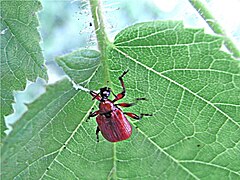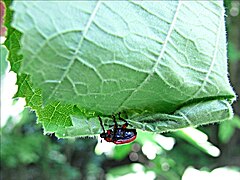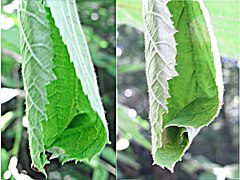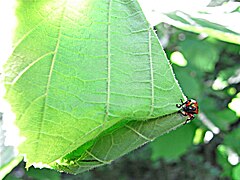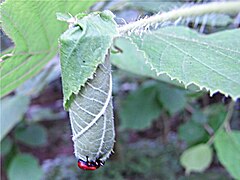Hazel leaf roller
| Hazel leaf roller | ||||||||||||
|---|---|---|---|---|---|---|---|---|---|---|---|---|
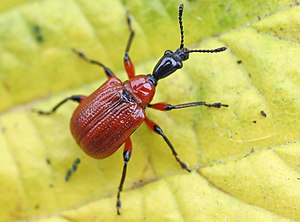
Hazel leaf roller ( Apoderus coryli ) |
||||||||||||
| Systematics | ||||||||||||
|
||||||||||||
| Scientific name | ||||||||||||
| Apoderus coryli | ||||||||||||
| ( Linnaeus , 1758) |
The hazel leaf roller ( Apoderus coryli ) is a beetle from the family of leaf roller . Because of the trunk-like elongated head, it is often mistakenly assigned to the weevils . Like this, however, it only belongs to the same superfamily , the weevil-like . On superficial examination it can be confused with the oak leaf roller ( Attelabus nitens ) and with Apoderus erythropterus . All three species produce leaf wraps in which the eggs are laid as a type of brood care .
The beetle is not protected in Germany, but in Schleswig-Holstein it is on the warning list as "potentially endangered".
Notes on the name
The species was first described by Linnaeus in 1758 as the second species of the genus Attelabus under the name Attelabus Coryli . Linnè adds to the description: Habitat in foliis Coryli, que in cylindrum convolvit .. ( Latin Lives on leaves of the hazel , which he rolls into a cylinder). This explains the species name coryli (Latin for hazelnut) and the German name "Hazel leaf roller".
Herbst divided the genus Attelabus in the sense of Linnaeus into Attelabus (in the narrower sense), Rhynchites and Apion . Olivier split the first genus again by separating the genus Apoderus : en séparant ... les espèces, dont la tête est postérieurement alongée et articulée par énarthrose au corcelet, de celles dont elle y est jointe et comme inplantée ( French by the Species whose head is elongated at the back and connected to the pronotum as if by a ball joint have separated from the species in which the head sits as if planted in the pronotum ) This explains the generic name Apóderus from Altgr. από apó, ab and δέρη dére, neck, which indicates that the head is clearly constricted.
The genus Apoderus is represented by only two species, which are assigned to different subgenera.
Characteristics of the beetle
The beetle becomes six to eight millimeters long. It can be clearly distinguished from the other two Central European red-black beetles of the same size class and with a short trunk. Apoderus coryli has a red pronotum , while the more rare Apoderus erythropterus has a black pronotum . From the oak leaf roller ( Attelabus nitens ), which is now assigned to a different subfamily, the hazel leaf roller differs in the presence of a neck, protruding eyes, the shape of the pronotum and shield and the structure of the wing covers .
The throat plate is in hazel leafroller front and cut off at the base (Fig. 1 and 5). From the front to the back it widens like a bell. The coloration can vary, but at least the rear part of the pronotum is red, only the front edge and occasionally a narrow longitudinal stripe at the front end of the pronotum are black. Like the head, the pronotum is very finely and scattered dotted .
The wing covers (Fig. 8) are short, their sides run parallel until just before the end. At the back they are broadly rounded together and do not completely cover the abdomen. The pronounced shoulders are significantly wider than the pronotum. Coarse stripes of dots subdivide the elytra, the third and fifth of the narrow spaces are raised like ribs in the base area (white arrows in Fig. 8). The fourth space is widened to the rear and has two further stripes of dots there (Fig. 8 left turquoise and green, a and b). In contrast to the glossy head and pronotum, the elytra due to a fine transverse wrinkle only appear matt. The label is much wider than it is long, triangular to trapezoidal and without point stripes.
The head is narrowed like a neck towards the pronotum (Fig. 5). The shape of the head is slightly different in males and females. In females it tends to taper off the neck, in males it is more round. The lateral eyes are hemispherical protruding. The temples behind are longer than the trunk and narrow backwards in a bell-shaped manner. The trunk is about the same length as it is wide. The antennae are only a very small distance from one another, a little in front of half of the trunk (Fig. 6). Unlike the majority of weevils, they are not kneeled, but rather stretched. The base phalanx is not particularly large, but it is significantly longer than the second antennae (Fig. 6). The antennae are a little longer in the male than in the female. The antennae are short and wide and run down the sides of the proboscis vertically (Fig. 5).
The legs are red at the base and black towards the end like the rest of the leg. The rails are finely serrated on the inside. On the front outside they end in a hook-like curved spur in the male (Fig. 7 left), in the female they end in two such spurs (Fig. 7 right). The tarsi are four-part. The third link is lobed and the claw link long. The claws are fused and imperforate at the base. The front hips are cone-shaped and touch.
biology
The females make leaf wraps (as a sequence of images Fig. 9, hanging wraps Fig. 3 and 4). In contrast to the "longitudinal rollers" among the leaf rollers, whose laps are rolled parallel to the leaf axis, the hazel leaf roller belongs to the "transverse rollers" in which the leaf axis is rolled up.
The type of incision for the wrap depends on the host plant. In the case of hazelnut leaves, the leaf is incised slightly curved on one side from the edge towards the central rib. The midrib is cut vertically, the cut ends shortly after it. Then the middle rib and occasionally the thicker ribs are notched several times on the cut side. This interrupts the supply of water and reduces the turgor pressure . In addition, the central rib is easier to roll. Mating can take place while the leaves are waiting until the leaves have withered sufficiently. The males are already waiting for the females to rest. Supported by the onset of withering, the leaf halves are placed on top of one another with the upper side facing inwards, so that the central rib forms one side and the leaf margin forms the other side of the double-layered leaf blade . This is now rolled up from the tip of the blade. The female stands with one half on the growing coil, with the other half on the part that has not yet been coiled and forces the two halves together with her legs.
During the winding process, a slit is gnawed in the part that has not yet been wound. This is bulged with the trunk into a pocket in which an egg is deposited. So the egg lies between the original leaf tops. Then the bag is rolled up in the wrap. This oviposition is not infrequently repeated. In the finished wrap there is usually one, often two and, in exceptional cases, up to four eggs.
After the leaf blade is rolled up, the edges are pierced with the proboscis along with the underlying layers of the compress. The jagged hole edges of the outer layers are pushed into the lower layers, the edges are so to speak "riveted" together. The rivets are sufficiently stable until the roll remains dimensionally stable after drying. The end of the roll, which is formed by the rolled-up edge of the sheet, was pushed inwards at the beginning of the rolling process and the roll was closed at the bottom. The end of the roll, which is formed by the rolled up central rib, is now also closed.
The compress now hangs on the part of the leaf blade that has not been gnawed through. There are two possibilities. Either the remaining connection is gnawed through by the beetle. He holds on to the base of the leaf and holds the compress with his hind feet. Then he drops it. There is usually enough moisture between the rotting fallen leaves for the larva to develop. In the other case, the coil is not separated and is supplied with sufficient moisture via the not yet separated part of the leaf blade (Fig. 3 and 4). The larvae will have fresh plant tissue available as food for a long time in the wrap that slowly tans from the outside. The coil can be close to the petiole or more in the tip area of the leaf.
With other host plants, the type of wrap may differ. In the more stable leaves of the black alder , the main vein is not cut, but the leaf blade is cut from both sides to the midrib. After completing the wrap, the midrib is also gnawed through and the wrap falls to the ground. The humidity there is high enough for the larva to survive. Thinner leaves dry out more easily and are therefore cut and rolled in the manner described for hazelnut leaves. Thicker leaves, on the other hand, contain enough moisture and the roll will be bitten off as a result.
The female walks along the edge of the leaf in search of a suitable leaf to lay eggs. It also bites the leaf several times. At least in the case of the related species Apoderus balteatus, experiments show that the size and thickness of the leaf is recorded by a fixed way of pacing the leaves and by biting. A sheet is then chosen that is the right size for the number of eggs that are placed in the resulting wrap.
Several wraps can be made per day. The egg-laying time can stretch over several weeks.
The larvae hatch from the yellowish eggs and first eat the egg shell and then feed on the surrounding plant material of the wrap. In the following stages, the larvae turn salmon red. They remain in the coil in which the black, thread-like excrement of the larvae collects.
Pupation also takes place in the leaf wrap. The beetles hatch in summer. These in turn begin with the pairing, the production of swaddles and the laying of eggs. So there are two generations per year. The second generation larvae overwinter in the coil, which falls off towards the end of the year at the latest. They do not pupate until the following spring. This applies to Central Europe. For Northern Europe, however, it is stated that the animals hatched in summer no longer reproduce in the same year. They overwinter as adults and mating and oviposition do not take place until the following spring. The development cycle would therefore be one year. It is not uncommon for insects that the development time of a species is longer or shorter depending on the climatic conditions.
- Fig. 9: Production of a leaf roll from a hazelnut leaf with subsequent separation of the roll
Distribution and occurrence
The beetles can be found in Central Europe from May to September on the host plant, the hazel . Other deciduous trees, such as alder , birch or hornbeam, are only used as host plants in exceptional cases . Depending on the occurrence of the host plants, we find the species in deciduous forests in clear places, for example at forest edges, often on the underside of the leaves of the host plant. The species is distributed in Europe, North Africa and parts of Asia.
literature
- Heinz joy , Karl Wilhelm Harde , Gustav Adolf Lohse (ed.): The beetles of Central Europe . tape 10 : Bruchidae – Curculionidae 1 . Goecke & Evers , Krefeld 1981, ISBN 3-87263-029-6 .
- Adolf Horion: Beetle science for nature lovers . Vittorio Klostermann, Frankfurt am Main 1949
- Hans Gønget: The Nemonychidae, Anthribidae and Attelabidae (Coleoptera) of Northern Europe Fauna Entomologica Scandinavica, Volume 38, 2003, ISBN 90-04-13265-1
- Brehm's Thierleben. General knowledge of the animal kingdom, ninth volume, fourth division: Invertebrates, first volume: The insects, millipedes and spiders. Leipzig: Verlag des Bibliographisches Institut, 1884, pp. 140-141 on the Internet
- Klaus Koch : The Beetles of Central Europe . Ed .: Heinz Freude . tape 3 : ecology . Goecke & Evers, Krefeld 1992, ISBN 3-87263-042-3 . P. 176
Individual evidence
- ↑ a b Distribution, systematics and synonyms of Apoderus coryli
- ↑ Red lists at BioNetworkX
- ↑ C.Linnaeus: Systema Naturae per Regna tria naturae, secundum classes, ordines, genera, species, cum characteribus, differentiis, synonymis, locis. Tomus I. Editio decima, reformata Stockholm 1758 first description page 391 | 387
- ↑ Sigmund Schenkling: Explanation of the scientific beetle names (species)
- ↑ GA Olivier: Entomologie, ou histoire naturelle des insectes, avec leurs caractères génériques et specifiques, leur description, leur synonymie et leur figure enluminée Coléoptères. Tome second Paris 1790 p. 1 Division of Attelabus
- ↑ Sigmund Schenkling: Explanation of the scientific beetle names (genus)
- ↑ Apoderus in Fauna Europaea. Retrieved March 5, 2013
- ↑ Apoderus Apoderus (subgenus) in Fauna Europaea. Retrieved March 3, 2013
- ↑ Apoderus Compsapoderus (subgenus) in Fauna Europaea. Retrieved March 3, 2013
- ↑ Daanje, A. The leaf rolling technique of Apoderus Coryli L. and Attelabus Nitens Scop. (Coleoptera Attelabinae) Behavior, Vol. 11. Numbers 2-3 1957, Abstract ( page no longer available , search in web archives ) Info: The link was automatically marked as broken. Please check the link according to the instructions and then remove this notice.
- ↑ SAKURAI K Leaf size recognition and evaluation of some attelabid weevils. II: Apoderus Balteatus Behavior vol 106 no 3-4 pp. 300-317 1988









